This article dives into nine play ABA techniques that are all about boosting child development! 🎉 It highlights how tailored activities can really help children grow in communication, social interaction, and independence. For example, methods like Natural Environment Teaching and Pivotal Response Training use play to make learning fun and engaging, leading to better developmental outcomes through enjoyable interactions.
Imagine your child laughing and learning at the same time! These techniques not only foster growth but also create meaningful moments between you and your child. Let’s explore this together and see how these approaches can make a difference in your child’s life. We’re here to help you every step of the way! 😊
Engaging children in play is so much more than just a source of entertainment; it’s a fantastic way to support their development, especially when it comes to Applied Behavior Analysis (ABA) therapy. By using play-based techniques, caregivers and therapists can craft dynamic learning experiences that not only nurture essential skills but also resonate with children’s natural inclinations. The real challenge? Figuring out how to implement these strategies effectively to make the most impact.
So, what specific play ABA techniques can we use to boost child development? And how can families actively join in on this transformative journey? Let’s explore this together!
At Rori Care, we embrace a customized approach to play aba therapy, focusing on activity strategies tailored to meet the unique needs of each child. By incorporating play aba into our sessions, our clinicians create engaging and effective learning experiences that boost communication, social interaction, and independence. This method not only makes therapy enjoyable but also incorporates the concept of play aba, aligning beautifully with children's natural learning styles and fostering a deeper impact on their development.
For example, our therapists often use favorite toys or games to play aba, which helps teach essential skills, ensuring that every session is both fun and informative. Research shows that programs offering 25 to 40 hours of ABA therapy weekly—backed by over 20 studies—can lead to significant improvements in various developmental areas, including social skills and adaptive behaviors. Plus, statistics reveal that 66% of youth referred for ABA therapy start treatment and remain engaged for at least 12 months, highlighting the commitment and effectiveness of ongoing care. This tailored approach is vital for maximizing the benefits of ABA therapy, allowing for real-time adjustments based on each child's responses and progress.
Current best practices in play aba therapy highlight the importance of family involvement, which is key to achieving successful outcomes. Regular evaluations help ensure that therapy aligns with each child's evolving needs. By focusing on activities, our therapists create a nurturing environment that encourages learning and development through play aba, ultimately leading to better results for youth with autism. And with a projected growth rate of around 22% in demand for ABA services, the recognition of these techniques' importance continues to grow. It's also important for parents to understand the financial aspect, as the average cost of supporting an individual with autism is about $60,000 per year.
Let’s explore this together! We’re here to help you every step of the way!
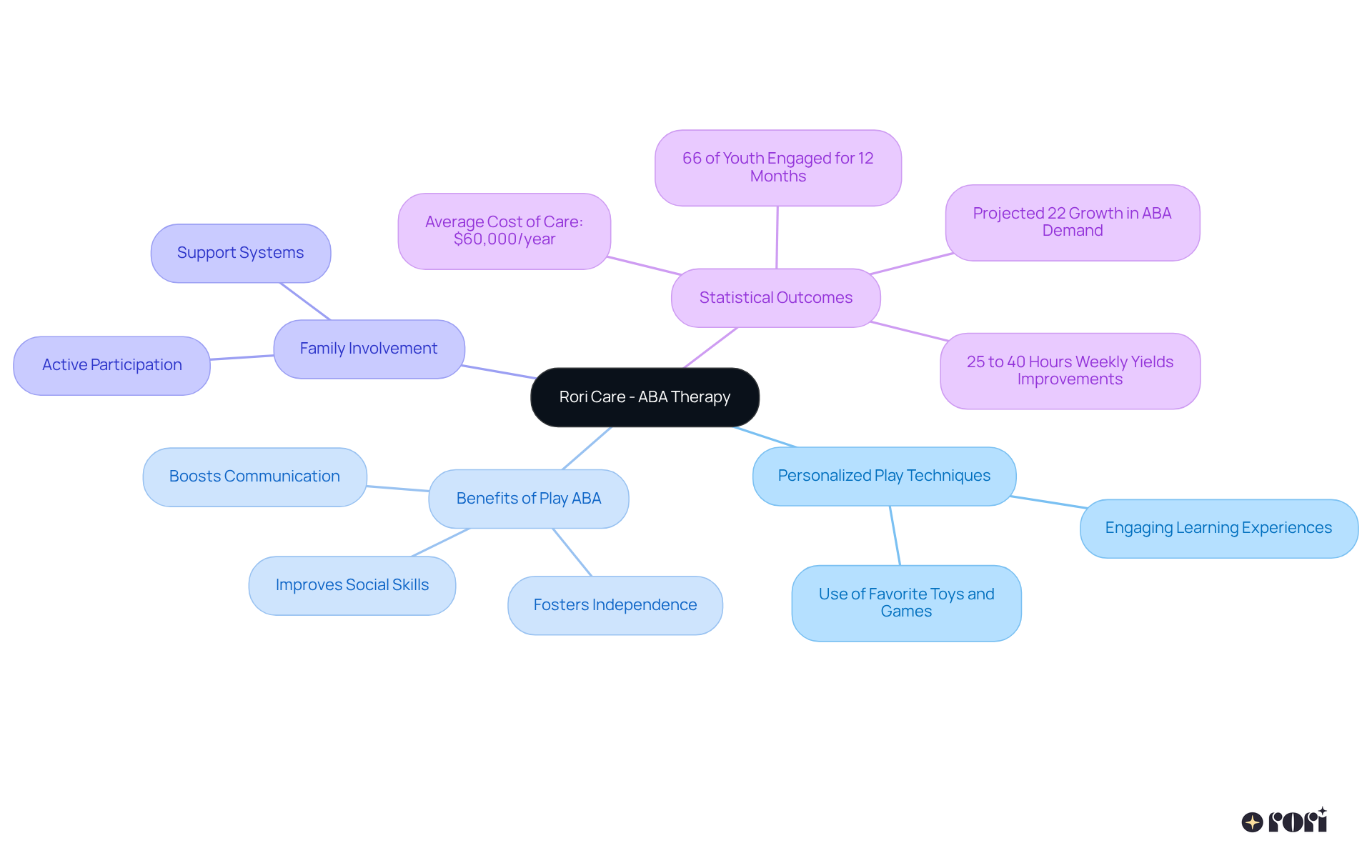
Natural Environment Teaching (NET) is a fantastic ABA technique that encourages young people to play ABA by utilizing their everyday surroundings to make learning engaging! By weaving learning objectives into familiar contexts—like home, school, or local parks—therapists create fun opportunities that feel less like formal instruction and more like enjoyable activities. For instance, imagine a counselor taking a young person to their favorite park to boost social skills by encouraging interactions with friends during playtime.
This approach really amps up motivation and involvement, allowing young individuals to practice essential skills in real-life situations. Studies show that kids involved in NET experience a whopping 30% increase in language use during spontaneous interactions compared to those in traditional treatment. Plus, NET not only enhances communication and social skills but also boosts overall engagement, leading to better developmental outcomes. By mixing fun with routine interactions, NET makes learning more relevant and applicable in kids' daily lives.
Even more impressive, 60% of participants showed improvements in intellectual functioning, and this method has been shown to increase parent engagement by 25% during treatment sessions. As NET encourages caregiver involvement by integrating learning opportunities into everyday activities, it creates a collaborative environment that enriches therapy outcomes. Let’s explore this together and see how NET can make a difference in your child's life!
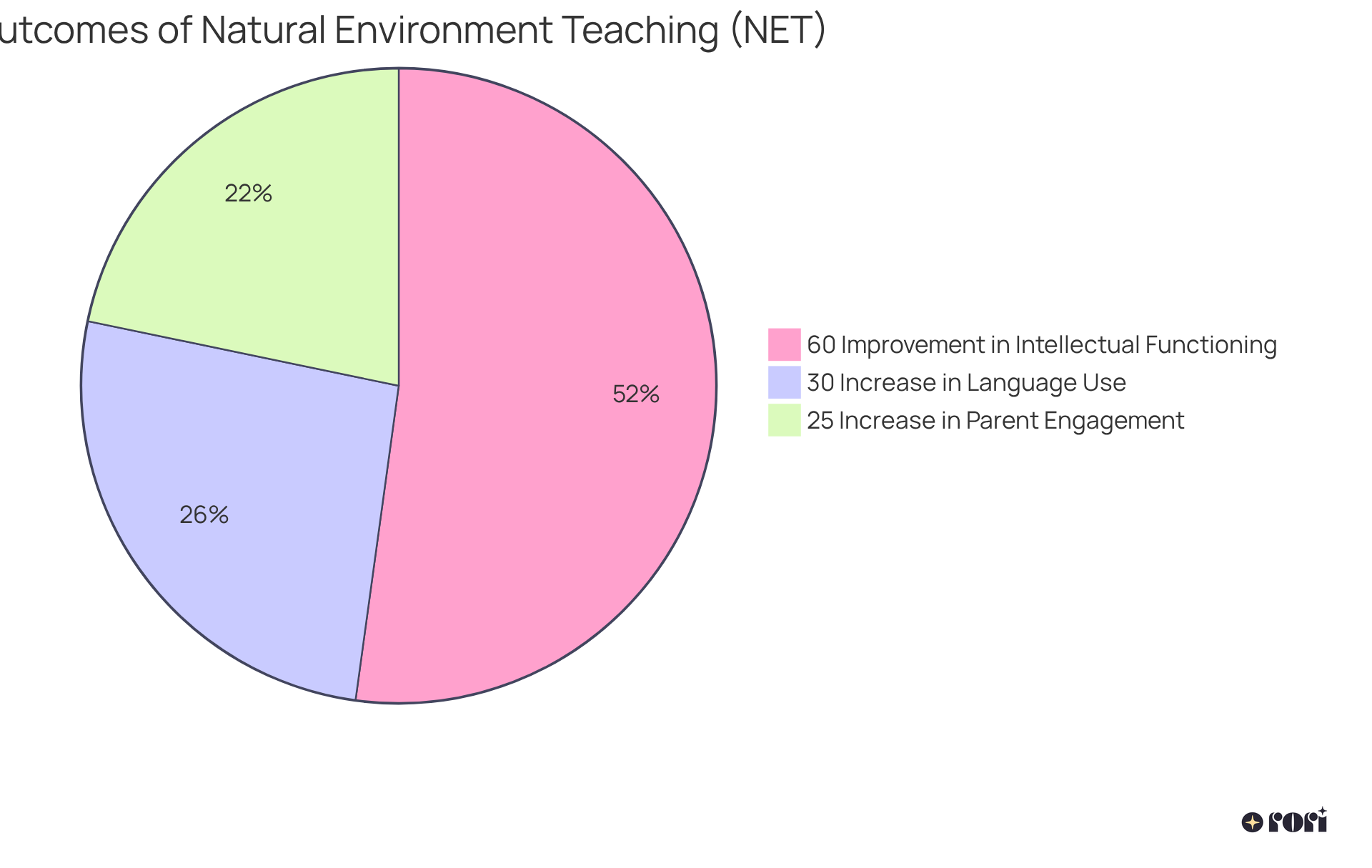
Pivotal Response Training (PRT) is a naturalistic approach that focuses on key areas of development, especially motivation and social initiation, to boost engagement during play. By honing in on these important behaviors, therapists create fun opportunities for kids to practice essential skills. For example, letting a child pick a game they enjoy really ramps up their motivation to join in, leading to more meaningful interactions.
PRT strategies include:
These techniques not only make learning fun but also empower young ones to take an active role in their therapy. In fact, studies reveal that:
This showcases the positive effects of these strategies on development.
Therapists often share that engaging kids through play aba in PRT fosters a positive therapeutic relationship, which is crucial for achieving great results. By blending learning with enjoyable activities, children are more likely to remember skills and gain confidence in social situations, setting the stage for greater independence and a better quality of life. PRT also emphasizes the transfer of skills learned in therapy to everyday life, ensuring kids can apply what they've learned in various contexts. Best of all, PRT doesn’t require any special equipment or materials, making it a practical choice for parents eager to try these strategies at home. Let’s explore this together!
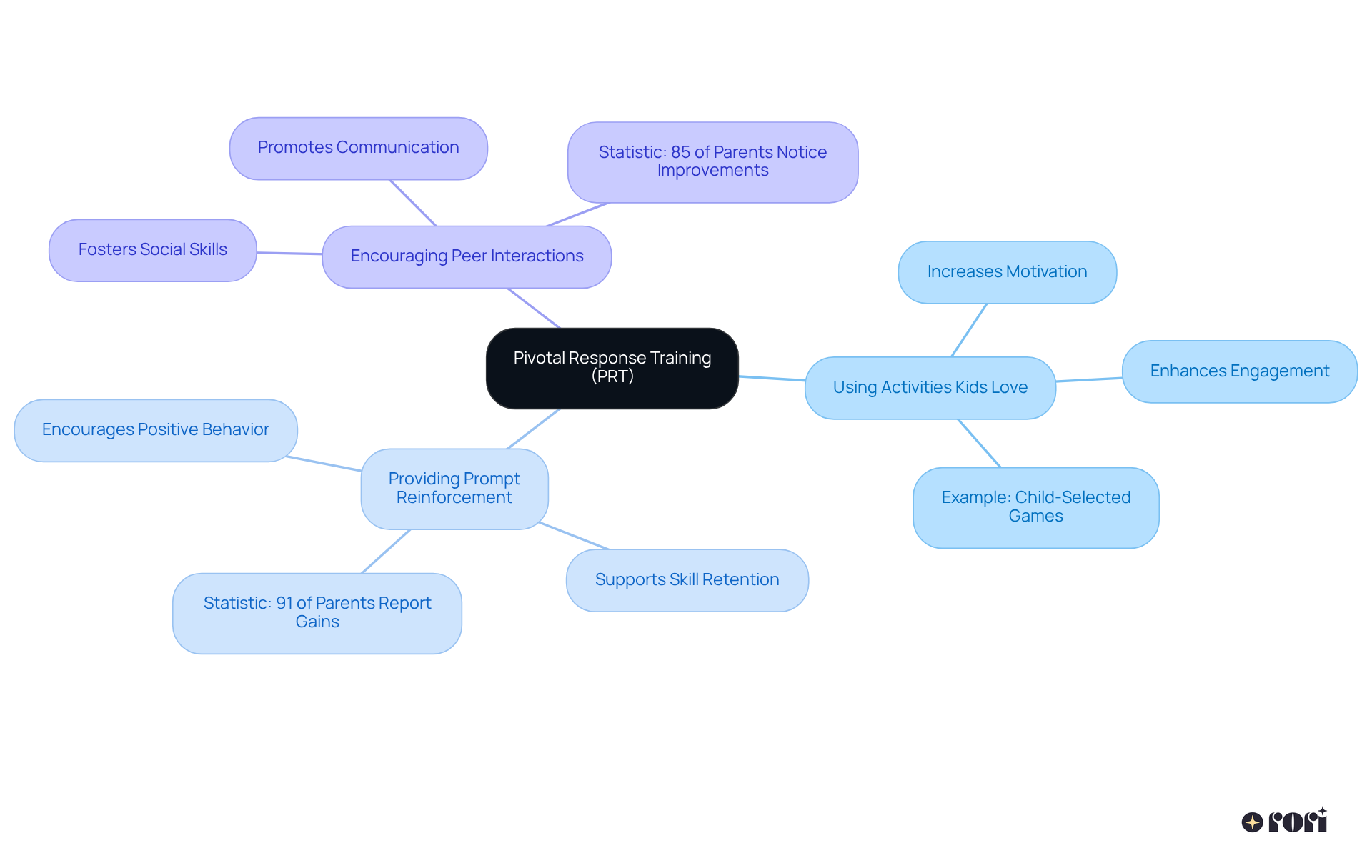
Organized play is all about planned activities designed with specific learning goals in mind. This approach allows therapists to focus on important skills efficiently. For instance, board games can teach young individuals vital aspects of social interaction, like taking turns and following rules. By creating a structured environment, therapists can guide kids through activities that reinforce positive behaviors and skills, helping them understand societal norms better.
This method not only clarifies what’s expected but also gives young individuals plenty of chances to practice in a safe setting. Research shows that organized activities, such as play aba, significantly boost cognitive, social, and emotional development, making them a key part of ABA therapy. Clinicians emphasize that these structured activities play aba a crucial role in learning, as they provide a framework for children to explore and develop their abilities safely and effectively.
Let’s explore this together! By engaging in organized play, we can support our children in a way that feels both fun and purposeful. We’re here to help you every step of the way!

Parent-led solutions in play ABA offer a wonderful opportunity for families to actively engage in their children's development, especially when it comes to improving play skills. By providing parents with the right training and resources, they can easily implement strategies at home that reinforce what their kids learn in therapy. For example, caregivers can join in on role-playing games that mimic therapeutic activities, allowing little ones to practice their skills in a fun and familiar setting.
This collaborative approach not only strengthens the bond between parent and child but also promotes consistency in learning. Research shows that children whose parents are actively involved in their therapy tend to achieve better outcomes. In fact, studies have shown that parent-led interventions can lead to higher rates of skill acquisition and participation. It’s fascinating to note that the demand for certified ABA therapists skyrocketed by 5,852% from 2010 to 2021, underscoring the growing need for accessible therapy options and supporting the case for parent-led solutions. Parents can track their child’s progress and offer immediate feedback, which can be incredibly motivating for their little learners.
Current best practices highlight the significance of training parents in ABA techniques, enabling them to deliver effective interventions right at home. Parents typically receive over 40 hours of training in ABA before starting treatment, ensuring they are well-prepared to support their child's development. As Anurag Garikipati wisely stated, "Parent-led ABA can lead to goal achievement and improved clinical outcomes and may be a viable solution to overcome treatment access barriers that delay initiation or continuation of care." By fostering an environment where parents can be change-makers, the potential for positive results in activities and overall development is greatly enhanced.
To get started with these strategies at home, parents can carve out specific time each week for play ABA activities that align with their child’s therapy goals. Let’s explore this together and see how we can make a difference in our children's lives!
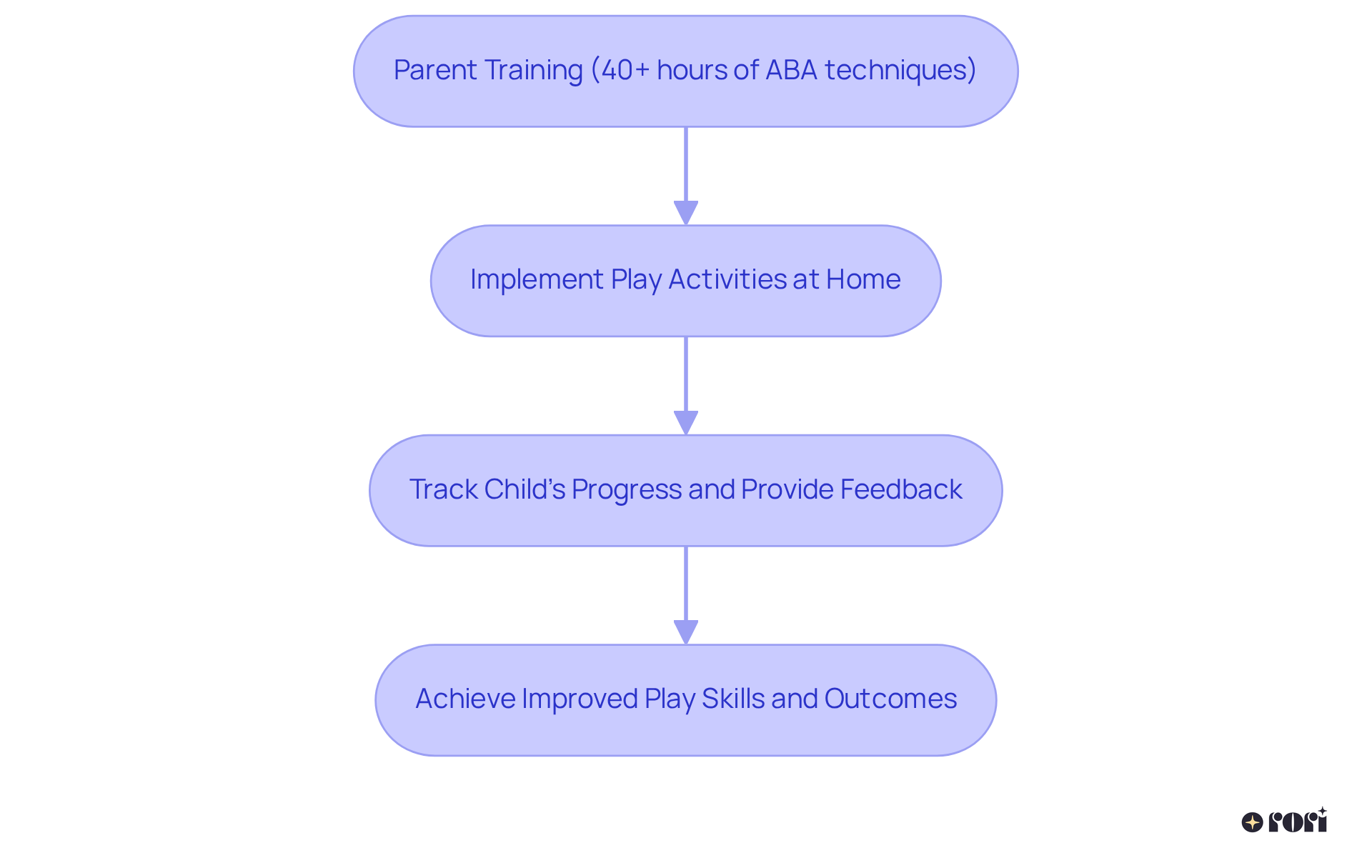
Social skills training is such an important part of ABA therapy, and guess what? Play aba is a fantastic way to build these skills! Interactive games and group activities give kids the chance to practice essential interpersonal behaviors like sharing, taking turns, and communicating effectively with their peers. Think about cooperative games that emphasize teamwork; they really encourage kids to negotiate roles and work together toward common goals, helping them learn how to collaborate with others.
When we weave interpersonal development training into fun activities, it creates a relaxed environment where kids can confidently navigate social interactions. This playful approach encourages us to play aba, which not only boosts communication skills but also nurtures friendships and emotional bonds that are crucial for overall growth. Recent studies show that kids engaged in organized recreational activities make remarkable strides in their interpersonal abilities, with about 88% of data indicating positive improvements in communication outcomes. Experts remind us that play aba isn’t just a pastime; it’s a key ingredient in developing the interpersonal skills kids need for successful interactions in all sorts of settings. As one expert puts it, 'Play aba is crucial for kids to learn how to engage with others and develop the skills they need for lasting interpersonal success.' Plus, getting started early is essential, as it lays the groundwork for effective social skills development. So, it’s really worth considering how to involve your little ones in these enriching activities. Let’s explore this together!
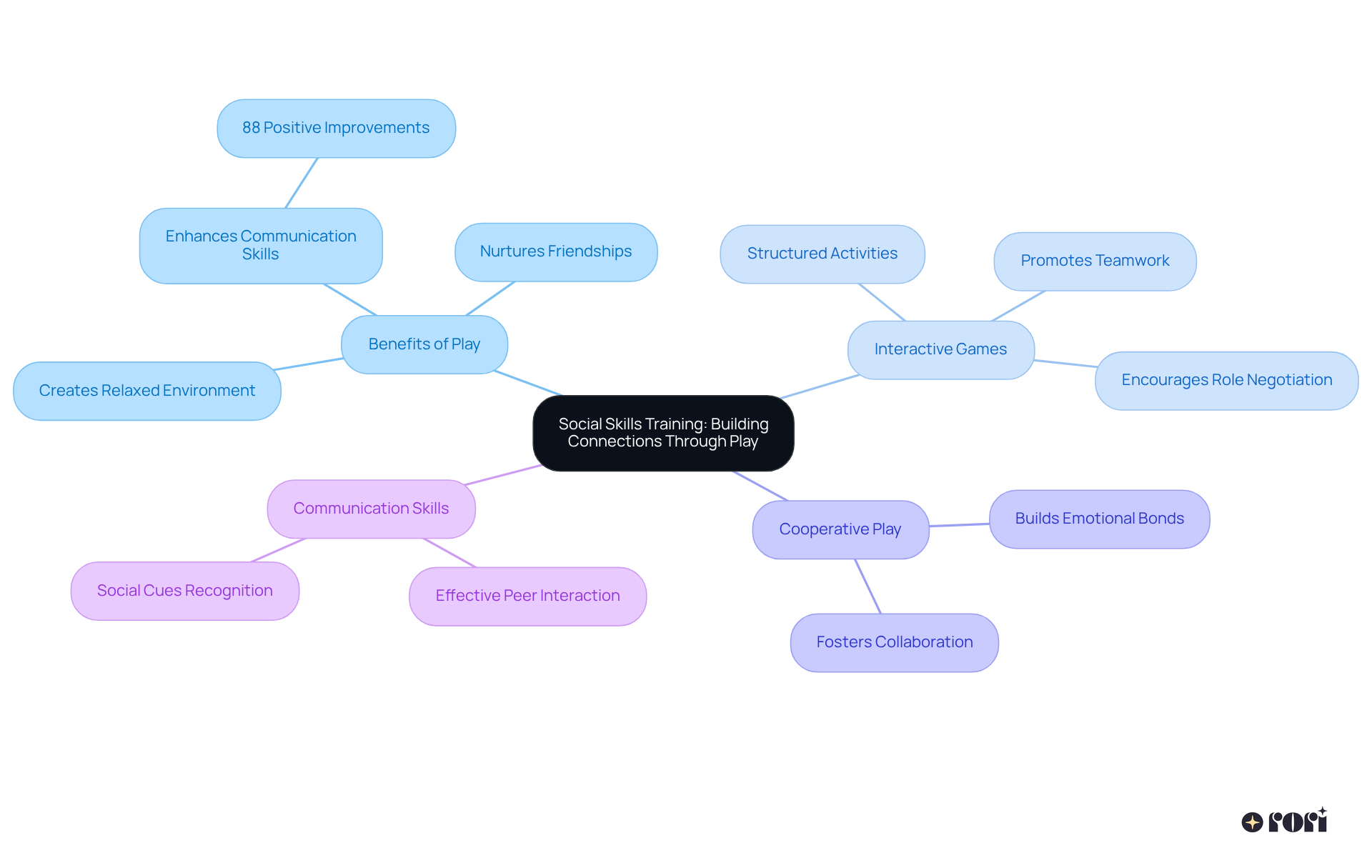
Visual supports, like pictures, symbols, and charts, are super important for making play activities more engaging! By using clear visual signals, therapists can easily share expectations and instructions, which encourages young ones to join in the fun. For example, a visual timetable during playtime can really help kids navigate through different activities. This not only eases any worries they might have but also boosts their excitement to participate!
These supports do more than just improve communication; they also promote independence. Kids can feel more confident as they navigate recreational situations on their own. Research shows that using visual aids consistently can lead to richer interactions and a better grasp of social cues. Exciting new tools, like emotion thermometers and choice boards, take things a step further by letting kids express their feelings and make decisions visually. Choice boards, in particular, are fantastic for empowering young learners by giving them clear visual options for decision-making, which is so important for building autonomy.
As therapists have noticed, incorporating these tools into play ABA not only enhances the overall experience but also nurtures essential skills for social interaction and emotional management. Plus, visual supports help set up routines, creating a structured environment that can really help reduce anxiety and foster a sense of safety for children with autism. Let’s explore this together and see how these tools can make a difference!
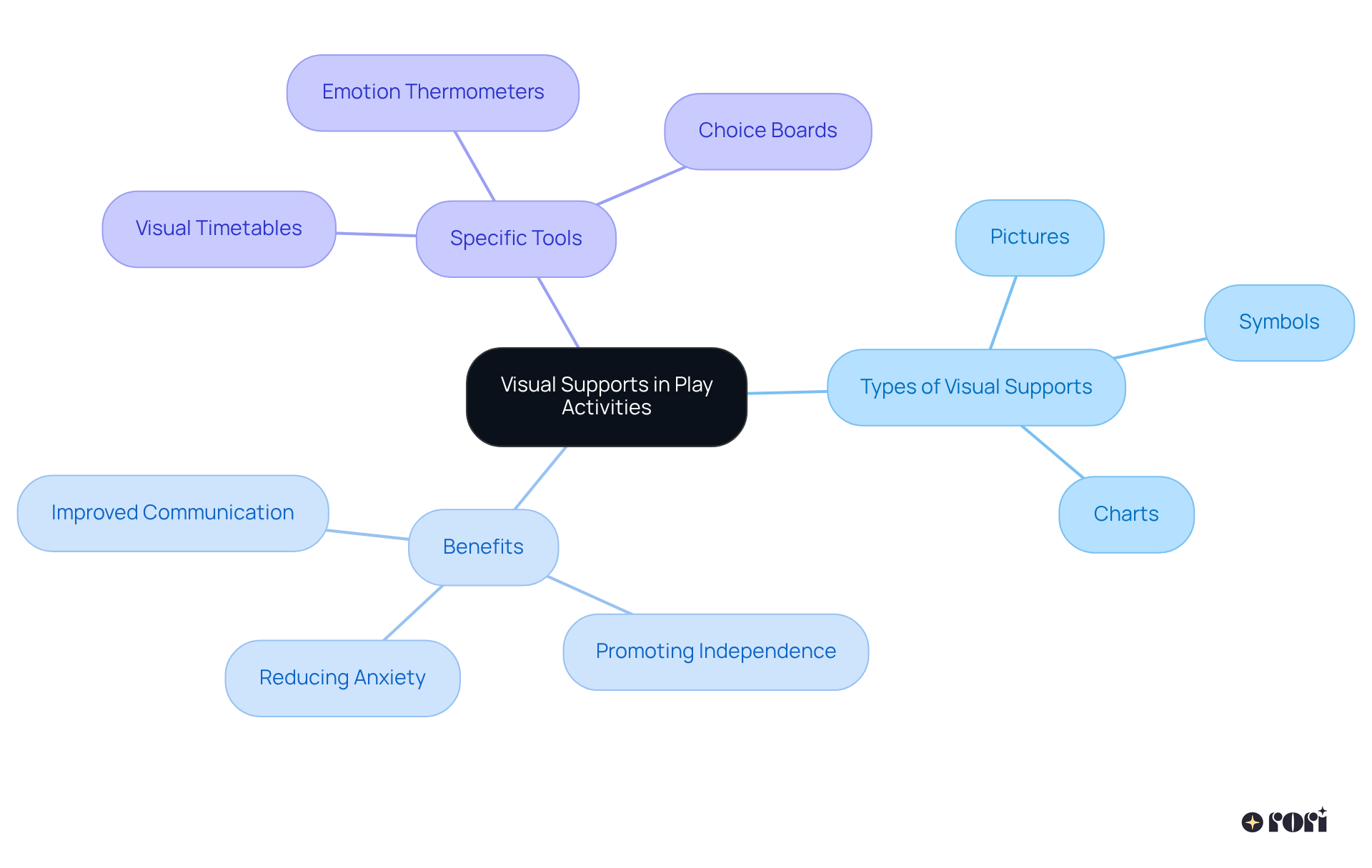
Task analysis is a key technique in ABA therapy that helps break down complex skills into smaller, manageable steps. This makes learning so much easier and more effective! It's especially useful during playtime, where therapists can play aba to teach specific skills in a structured way. For example, when introducing a new game, a therapist might outline essential steps like:
Research shows that task analysis leads to great outcomes for individuals with autism, improving their self-care, communication, and daily skills. By simplifying tasks, kids can focus on mastering one skill at a time, which really boosts their retention and understanding. Plus, this organized approach not only enhances learning but also builds confidence as children actively engage in play aba activities.
Task analysis equips kids with the tools they need to play aba in various situations, promoting independence and social interaction. As healthcare professionals often say, "Dividing skills into manageable parts is crucial for enhancing the learning experience and helping children thrive on their developmental journey." And the best part? Task analysis is versatile! It can be used to teach a variety of skills, from daily living tasks to academic skills, making it an invaluable resource in ABA therapy.
Let’s explore this together! If you’re looking for ways to support your child’s learning journey, task analysis might just be the perfect tool to consider.
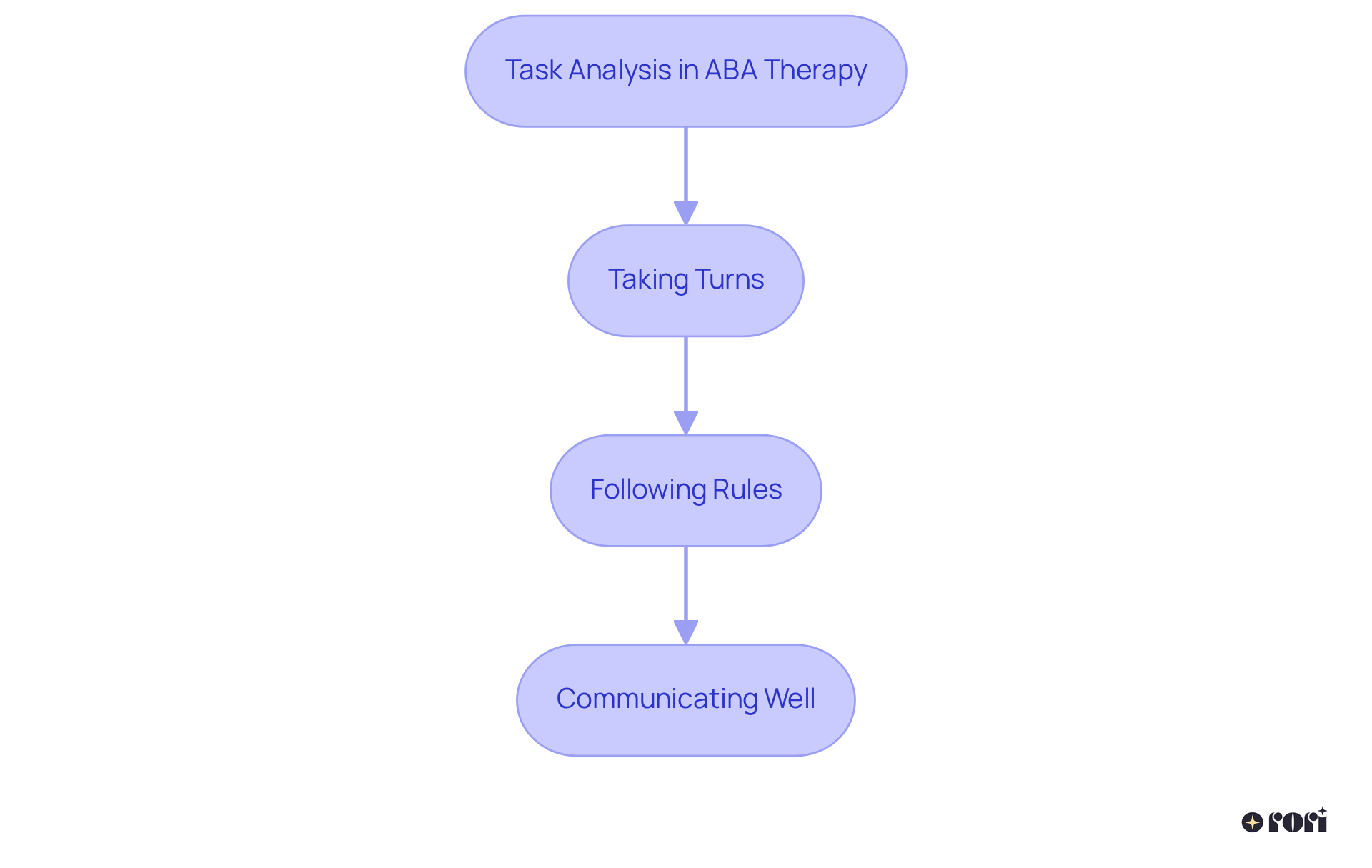
Reinforcement strategies play ABA a vital role in therapy, especially when it comes to encouraging our little ones during fun and educational activities. 🌟 By offering prompt incentives for preferred actions, we can significantly boost their involvement, motivating them to dive into play more actively. For example, therapists might use praise, tokens, or even access to favorite activities as reinforcement when a child shares a toy or follows game rules.
Research shows that these strategies not only enhance motivation but also help kids grasp the connection between their actions and positive outcomes. Play ABA is essential for growth, supporting cognitive, physical, emotional, and overall well-being. When we consistently apply these reinforcement techniques, we create a more engaging and productive environment, leading to improved learning and social skills.
Remember what Fred Rogers said: "Play is often talked about as if it were a relief from serious learning. However, for youngsters, recreation is important education. Play is really the work of childhood." This highlights how effective reinforcement can promote development in our children when we play ABA, backed by caring clinicians who truly understand their needs.
Let’s explore this together! We’re here to help you every step of the way!
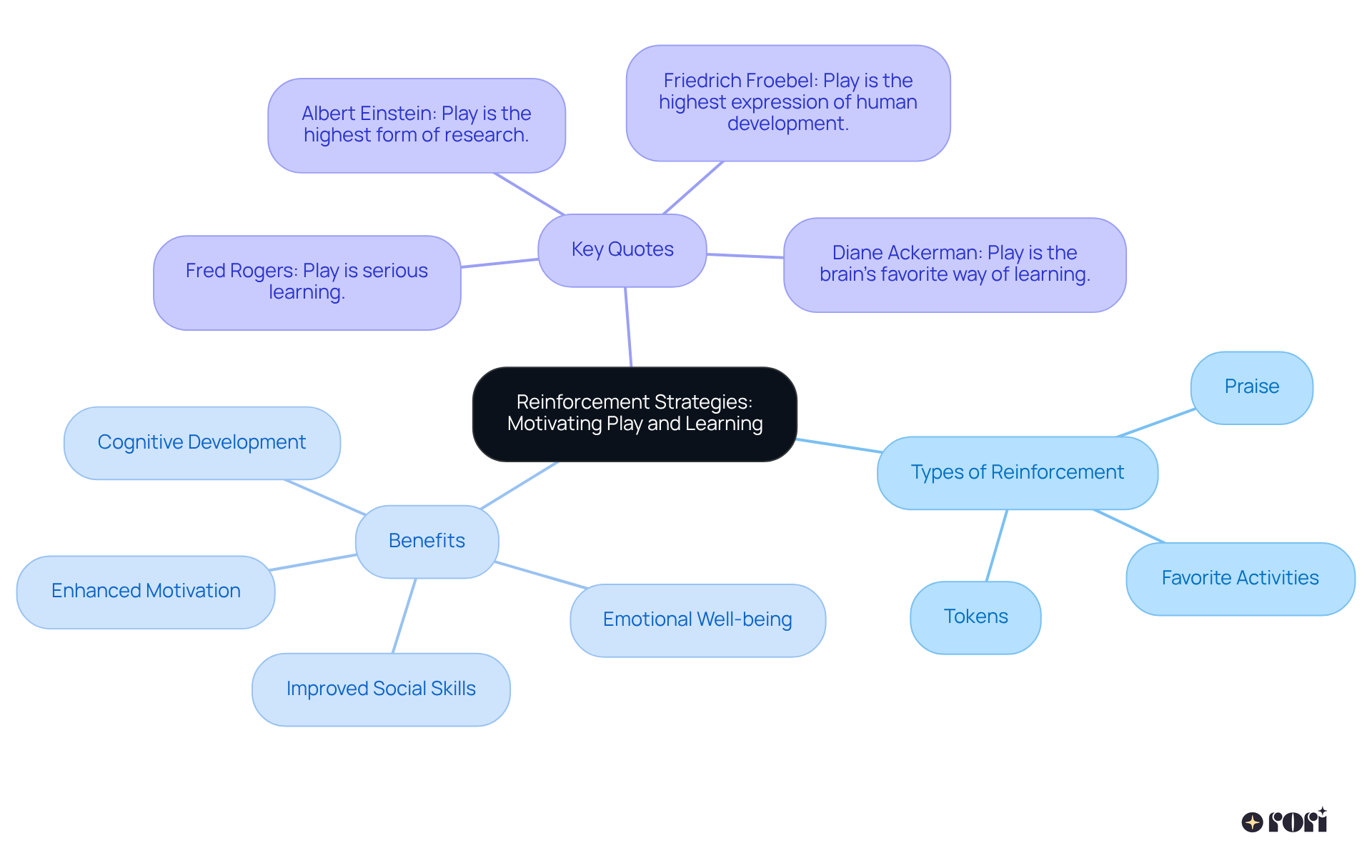
Collaborative play methods are so important for promoting teamwork and improving social skills among young individuals. When kids engage in activities that require them to work together—like group games, building projects, or role-playing scenarios—they naturally enhance their communication and negotiation skills. Through these fun interactions, they cultivate essential abilities such as sharing, problem-solving, and empathy.
Participating in cooperative activities not only boosts interpersonal skills but also fosters a sense of belonging among friends. Experts in autism care emphasize the importance of creating opportunities for these activities, as they provide a nurturing environment for youngsters to practice and enhance their interactions. Research shows that group therapy in ABA centers helps youth on the autism spectrum develop vital teamwork skills, leading to significant improvements in their confidence during interactions and problem-solving abilities.
By encouraging collaboration through engaging activities, youngsters learn to navigate social norms and build meaningful relationships, setting the stage for future success in social settings. Plus, having a multidisciplinary team involved in ABA therapy enhances the effectiveness of these collaborative techniques, ensuring that interventions are tailored to each child's unique needs. Positive reinforcement strategies, like praise and rewards, further motivate ongoing participation and skill generalization, making collaborative play ABA a crucial part of effective autism care.
Let’s explore this together! Encouraging your child to engage in these activities can be a wonderful step towards fostering their social development and connection with others. We’re here to help you every step of the way!
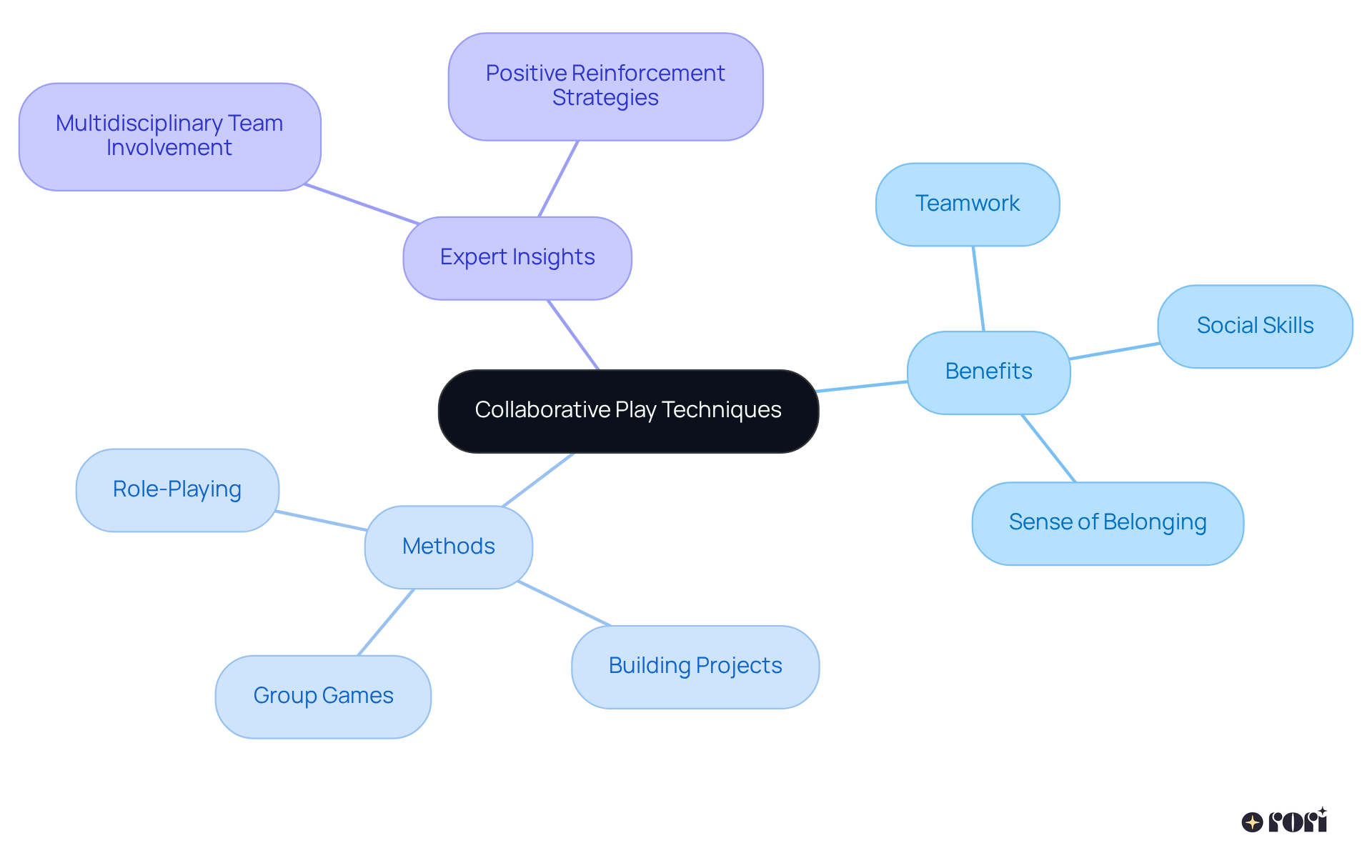
Incorporating play-based techniques into ABA therapy offers a transformative approach to child development. By tapping into children's natural love for play, these methods not only make therapy enjoyable but also create significant learning opportunities. Focusing on personalized strategies tailored to each child's unique needs ensures that therapy is both effective and engaging, ultimately leading to improved communication, social skills, and independence.
The article highlights several key techniques, including:
Each playing a vital role in fostering essential skills. NET uses everyday environments to enhance learning, while PRT emphasizes motivation and social initiation through fun activities. Structured play provides a safe and guided setting for children to practice their skills. Plus, the importance of family involvement and parent-led interventions shines through, showing that collaboration between therapists and families can lead to better outcomes and a richer experience for children.
Ultimately, embracing these play-based ABA techniques is more than just an innovative approach; it's a heartfelt call to action for parents, therapists, and caregivers alike. By actively engaging in these strategies, families can empower their children to thrive in social interactions and daily activities. As the demand for effective ABA services continues to grow, integrating play into therapy not only enhances learning outcomes but also nurtures joy and connection in the developmental journey. Let’s work together to make a meaningful difference in the lives of children, ensuring they have the tools they need to succeed and flourish!
What is Rori Care's approach to ABA therapy?
Rori Care uses a customized approach to play ABA therapy, focusing on activity strategies tailored to meet each child's unique needs. This method makes therapy engaging and effective, enhancing communication, social interaction, and independence.
How does play ABA therapy benefit children?
Play ABA therapy incorporates favorite toys or games to teach essential skills in a fun and informative way. Research indicates that 25 to 40 hours of ABA therapy weekly can lead to significant improvements in social skills and adaptive behaviors.
What is the importance of family involvement in play ABA therapy?
Family involvement is crucial for achieving successful outcomes in play ABA therapy. Regular evaluations ensure that therapy aligns with each child's evolving needs, fostering a nurturing environment that encourages learning through play.
What is Natural Environment Teaching (NET)?
NET is an ABA technique that encourages learning through everyday surroundings, making it engaging by integrating learning objectives into familiar contexts like home or local parks.
How does NET enhance learning?
NET enhances communication and social skills while increasing overall engagement. Studies show that children involved in NET experience a 30% increase in spontaneous language use and a 60% improvement in intellectual functioning.
What is Pivotal Response Training (PRT)?
PRT is a naturalistic approach that focuses on motivation and social initiation to boost engagement during play. It emphasizes using activities children love and encourages peer interactions.
What are the outcomes associated with PRT?
Studies indicate that 91% of parents noticed improvements in their children's communication and social engagement through PRT, with 85% highlighting enhancements in interpersonal skills.
How does PRT support skill transfer to everyday life?
PRT emphasizes the application of skills learned in therapy to everyday situations, ensuring children can use what they've learned in various contexts, contributing to greater independence and improved quality of life.
What are the financial considerations for families seeking ABA therapy?
The average cost of supporting an individual with autism is approximately $60,000 per year, which is an important consideration for families looking into ABA therapy services.